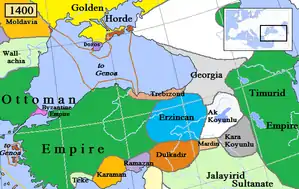Emirate of Erzincan | |
|---|---|
 Erzincan, c. 1400 | |
| Status | Emirate |
| Capital | Erzincan |
| Religion | Islam |
| Government | Monarchy |
| Emir | |
• 1348–1362 | Ahī Ayna |
• 1362–1379 | Pīr Ḥusayn |
• 1379–1403 | Muṭahharten |
Emirate of Erzincan was an emirate in East Anatolia, Turkey in the fourteenth and early fifteenth centuries.
History
Ahī Ayna (1348–1362)
A local ahī, Ahī Ayna purchased control of Erzincan from his predecessor sometime before 1348.[1] Ahī Ayna first appears in records as a vassal of Eretna circa 1348.[2] Michael Panaretos wrote that in June 1348, Ahī Ayna led a joint attack against the Empire of Trebizond together with Tur Alī Beg of Aq Qoyunlu Turkmens and Muḥammad Rikābdār, the emir of Bayburt. He returned to Erzincan after 3 days of campaign was inconclusive.[3]
Following Eretna's death, Ahī Ayna exercised autonomy and attempted to increase his sphere of influence.[4] An Armenian colophon of 1355 mentions that Ahī Ayna was attacked by "Khochay Yali," likely Khoja Latif of Bayburt.[5] In June 1362, Ghiyāth al-Dīn Ahī Ayna Beg went on an expedition in Georgia. He captured Akhaltsikhe, Samstskhe, and Atsquri, took 12,000 people captive, and had Manglisi pay jizya.[6] On 6 August 1361, Ahī Ayna continued his expedition in the region of Lazica, i.e. eastern territories of the Empire of Trebizond. In October of that year, he besieged but wasn't able to capture the fortresses of Golacha and Koukos.[7]
Ahī Ayna was the suzerain of three other emirates, namely those in Erzurum, Bayburt, and Karahisar. His core territory stretched from the Erzincan Plain southwards to Upper Euphrates Valley near Çaltı. Kemah was under the administration of a governor instead of a vassal emir like Ahī Ayna.[8] Although Ahī Ayna acted semi-independently during the reign of Ghiyāth al-Dīn Muḥammad I of the Eretnid Sultanate, an Eretnid coin minted in Erzincan from the year 1359 indicates that Ahī Ayna's subordinate position continued and he never declared independence.[9] Ahī Ayna died on 2–3 July 1362 reportedly as a shahīd (martyr), suggesting a violent death.[10]
Pīr Ḥusayn (1362–1379)
Pīr Ḥusayn, who was originally the ruler of Karahisar, arrived in Erzincan on 8 June 1362 and succeeded Ahī Ayna Beg. In Abū Bakr Quṭbī's Ta'rīkh-i taqwīm, he is mentioned as an emīr-zāda (lit. 'son of an emir') following the statement about Ahī Ayna's demise, hinting at the possibility he was Ahī Ayna's son.[11]
Pīr Ḥusayn's ascendance to the throne was not straightforward as Erzincan was in the midst of a civil war. He "gained independence" on 10 July,[11] having clashed with emirs opposing to his rule, who eventually fled to Bayburt and Tercan.[12] On 11 September, he gained control of Bayburt after a 32-day siege.[11]
Although there is a coin specimen minted in Erzincan for ʿAlāʾ al-Dīn 'Ali dating back to 1366, Pīr Ḥusayn most likely exercised further autonomy, especially following the temporary political vacuum caused by Ghiyāth al-Dīn Muhammad I's death in 1365. However, there aren't any sufficient accounts of the period until Pīr Ḥusayn's death in 1379.[13]
List of rulers
- Ahī Ayna (1348–1362)
- Pīr Ḥusayn (1362–1379)
- Muṭahharten (1379–1403)[14]
References
- ↑ Shukurov 1994, p. 32.
- ↑ Yücel 1971, p. 666.
- ↑ Yücel 1971, p. 667.
- ↑ Yücel 1971, p. 668; Sinclair 1989, p. 439.
- ↑ Shukurov 1994, p. 32–33.
- ↑ Yücel 1971, p. 669.
- ↑ Shukurov 1994, p. 33.
- ↑ Sinclair 1989, p. 439.
- ↑ Yücel 1971, p. 668–669; Sinclair 1989, p. 439.
- ↑ Shukurov 1994, p. 35–36.
- 1 2 3 Shukurov 1994, p. 36.
- ↑ Shukurov 1994, p. 36; Yücel 1971, p. 670.
- ↑ Yücel 1971, p. 670.
- ↑ Sinclair 1989, pp. 439–440.
Bibliography
- Bryer, Anthony (1975). "Greeks and Türkmens: The Pontic Exception". Dumbarton Oaks Papers. 29: 113–148. Retrieved 19 December 2023.
- Shukurov, Rustam (June 1994). "Between Peace and Hostility: Trebizond and the Pontic Turkish Periphery in the Fourteenth Century". Mediterranean Historical Review. Routledge. 9 (1): 20–72. doi:10.1080/09518969408569663.
- Sinclair, T. A. (31 December 1989). Eastern Turkey: An Architectural & Archaeological Survey. Vol. II. Pindar Press. ISBN 978-0-907132-33-2.
- Yücel, Yaşar (October 1971). "Mutahharten ve Erzincan Emirliği" [Mutahharten and the Emirate of Erzincan]. Belleten (in Turkish). 35 (140): 665–719. Retrieved 19 December 2023.